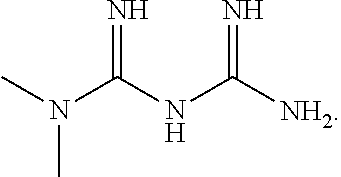Intranasal administration of pharmaceutical agents for treatment of neurological diseases
a technology for neurological diseases and pharmaceutical agents, applied in the field of neurological disorders diagnosis and treatment, can solve the problems of diabetes, mild cognitive impairment risk factor, and other prior art attempts to formulate once-daily doses of metformin, and achieve the effects of mild cognitive impairment, reduced risk factor for diabetes, and reduced drug safety
- Summary
- Abstract
- Description
- Claims
- Application Information
AI Technical Summary
Benefits of technology
Problems solved by technology
Method used
Image
Examples
example 1
Preparation of an Intranasal Formulation of Metformin-Transporter Moiety Complex
Preparation of Metformin Base
[0091]A procedure similar to that disclosed in U.S. Patent Application Publication No. 2005 / 0158374 for the preparation of metformin laurate is performed. An ion exchange column is packed with 200 g of the anionic resin, Amberlyst A-26 (OH) and a net weight is obtained. The column is rinsed first with deionized (DI) water (backflushed) and then rinsed with methanol containing 2% v / v DI water, with care taken to not allow the column to dry out.
[0092]Metformin hydrochloride (29.48 g) is dissolved in an eluant comprised of 650 mL methanol containing 2% DI water by volume. The metformin solution is passed through the column dropwise using a separatory funnel and the eluate is collected. The total metformin hydrochloride passed through is calculated to be less than the ion exchange resin's equilibrating point (capacity). The column is rinsed with 200 mL methanol containing 2% (v / v...
example 2
Clinical Testing for Patients Suffering from Mild Cognitive Impairment or Alzheimer's Disease
[0095]Patients are administered a formulation comprising metformin-linoleate prepared according to Example 1 via intranasal administration of an aqueous formulation, and testing is performed to see if the preparation improves memory in adults with mild cognitive impairment (MCI) or Alzheimer's disease. Primary outcome measures include changes in cognition, changes in glucose metabolism, changes in plasma biological markers, changes in CSF markers, changes in cerebral glucose metabolism. Escalating dosages of metformin-linoleate are tested and compared with a placebo for 4 months to see if the formulation facilitates memory for adults with AD and MCI. A subset of participants will participate in two sub-studies utilizing PET scans (prior to and at the end of treatment) to determine whether intranasal metformin-linoleate increases cerebral glucose metabolism, and lumbar punctures (LPs) before ...
example 3
Clinical Testing for Patients Suffering from CNS Cancers
[0102]Study participants should be diagnosed with a CNS cancer such as glioblastoma. Patients are administered a formulation comprising metformin-linoleate prepared according to Example 1 via intranasal administration of an aqueous formulation, and testing is performed to see how the treatment affects tumor glucose uptake and metabolism. Primary outcome measures include changes in cognition and other neurological parameters, changes in glucose metabolism, changes in plasma tumor markers, changes in CSF markers, changes in cerebral glucose metabolism. Escalating dosages of metformin-linoleate are tested and compared with a placebo for 4 months to see if the formulation reduces tumor size in patients diagnosed with CNS cancers, e.g., glioblastoma. A subset of participants will participate in two sub-studies utilizing PET scans (prior to and at the end of treatment) to determine whether intranasal metformin-linoleate increases cer...
PUM
| Property | Measurement | Unit |
|---|---|---|
| time | aaaaa | aaaaa |
| time | aaaaa | aaaaa |
| biocompatible | aaaaa | aaaaa |
Abstract
Description
Claims
Application Information
 Login to View More
Login to View More - R&D
- Intellectual Property
- Life Sciences
- Materials
- Tech Scout
- Unparalleled Data Quality
- Higher Quality Content
- 60% Fewer Hallucinations
Browse by: Latest US Patents, China's latest patents, Technical Efficacy Thesaurus, Application Domain, Technology Topic, Popular Technical Reports.
© 2025 PatSnap. All rights reserved.Legal|Privacy policy|Modern Slavery Act Transparency Statement|Sitemap|About US| Contact US: help@patsnap.com

